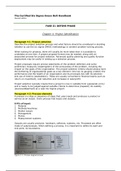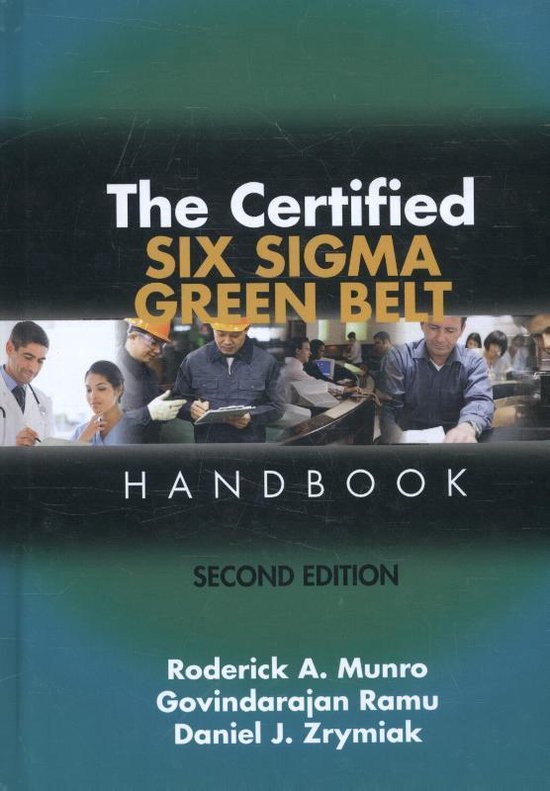The Certified Six Sigma Green Belt Handbook
Second edition
FASE II: DEFINE PHASE
Chapter 4: Project Identification
Paragraph 4.1: Project selection
Describe the project selection process and what factors should be considered in deciding
whether to use the six sigma DMAIC methodology or another problem-solving process.
When looking for projects, there will usually be more ideas than it is possible to
undertake at one time. A project proposal format may be needed, along with an
associated process for project selection. Advanced quality planning and quality function
deployment may be useful in setting up a selection process.
Project proposals require precise statements of the problem definition and some
preliminary measures (maatregelen) of the seriousness of the problem, including the
impact on the goals of the organization. The project selection criteria should always have
the furthering of organizational goals as a key element. One key to gauging (meten) the
performance and the health of an organization and its processes lies with its selection
and use of metrics (statistieken). These are usually converted to financial teams such as
return on investment, cost reduction and increases in sale/profit.
Project selection typically means that a project is now in suitable form (passende vorm)
and is ready to be judged against suitable criteria to determine (bepalen) its viability
(levensvatbaarheid) as a Lean Six Sigma project.
Paragraph 4.2: Process elements
A process is a step or sequence of steps that uses inputs and produces a product or
service as an output. Every process had inputs and outputs.
6 M’s of input:
1. Material
2. Methods/machines
3. Mother nature
4. Management
5. Money
6. Measurement systems
Outputs are usually products: hardware, software, systems, etc. Processes are often
made of subprocesses. When defining a process, it is important to define its start and
end point, its boundaries.
Figure 4.1: Process diagram/model
,Paragraph 4.3: Benchmarking
Understand various types of benchmarking (producten en werkwijzen vergelijken met
een soort gelijke organisatie), including competitive, collaborative and best practices.
Improving processes and products is often aided by comparing the current state with
outstanding processes or products. In some cases, the comparison will be with other
divisions of the same company and in other cases, external comparisons are more
appropriate. Benchmarking often assists a Six Sigma team in setting targets and finding
new ways to achieve them.
Several types of benchmarking:
Internal benchmarking
o Advantage: provides easy access to other departments in the same company.
However
o Disadvantage: the search for exceptional performance is often limited by the
company’s culture, norms and history.
Competitive benchmarking
o Advantage: forces an organization to take an external perspective
o Disadvantage: focusing on industry practices may limit opportunities to achieve high
levels of performance, particularly if a given industry is not known for its quality.
Functional benchmarking
o Compares similar functions, typically outside the organization’s industry, and provides
ample (ruime) opportunities to seek out benchmarking partners.
Collaborative benchmarking
o Advantage: refers to the cooperation between various functions or organizations to
achieve benchmarking results.
o Disadvantage: collaborative benchmarking may permit access to specific
benchmarking partners, that may not exist with the other types of benchmarking.
You can find do’s and don’ts for benchmarking on page 80.
Paragraph 4.4: Process inputs and outputs
Identify process input and output variables and evaluate their relationships using the
supplier, inputs, process, output, customer model (SIPOC).
Everything we do can be defined in terms of a process or system. When planning to
study a process or system, it is very important to first identify the boundaries to work
within. The two primary tools used to identify process boundaries are the basic process
model (figure 4.1) and the SIPOC-diagram (figure 4.2).
The basic process model provides a quick high-level look at the process, but in some
cases, may be too simplistic to provide an improvement team with a clear understanding
of the process/problem to work on and the boundaries of where and when to stop.
The SIPOC-diagram can be enhanced (verbetert) by also capturing the requirements of
the process and customer (shown in figure 7.15). When identifying the process, it is
important to recognize that processes usually affect multiple departments and
organizations. The SIPOC-diagram can help in identifying these organizations and
functional areas as process suppliers and customers. The flowchart (especially in swim-
lane style) and process map are other tools that can be used to help recognize these
interactions.
, Suppliers Inputs Process Outputs Customers
Providers of the Resources required Top-level Deliverables from Any organization
required by the process to description of the process that receives an
inputs/resources to obtain the intended activity. (hardware, output or
ensure that the output. software, systems, deliverable from
process executes data, information, the process.
as planned. etc.)
Input
boundaries
Process
being
reviewed
Output
boundaries
Figure 4.2: Basic SIPOC-diagram
Paragraph 4.5: Owners and stakeholders
Identify the process owners and other stakeholders in a project.
Process owners → those who have responsibility for the execution and implementation
of a specific process. Those that are responsible for the definition, execution,
maintenance and improvement of the process.
Stakeholders → those who have vested interest in the process and/or its products and
outputs. For example, customers, suppliers, employees, investors and communities.
Stakeholder interest and involvement with the process may change over time depending
on economic, contractual, and other influences.
The most effective methods of process improvement utilize team representing process
owners and all stakeholders, because:
• Stakeholders have the best knowledge base about the process
• Stakeholders tend to have the best ideas for process improvement
• Stakeholders are often the most aware of unintended consequences of process
changes
• Stakeholders buy-in is usually necessary to implement real process improvement
Chapter 5: Voice of the Customer (VOC)
Paragraph 5.1: Customer identification
Identify the internal and external customers of a project, and what effect the project will
have on them.
The question: “Who is the customer of the project?” should always be asked up front on
any project, and in many cases, a pan is needed to go talk to those individuals.
Customers can be found internal to the project (individuals who work in the process) and
external to the project (individuals outside the boundaries of the project), internal and
external customers.
When reviewing the external customer list, remember to include people who might be
outside of your direct organization as stakeholders (board of directors, organizations who
buy services or products, neighbors, government agencies, etc.).






